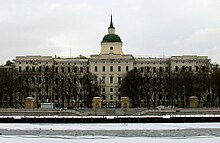Karl Blank
| Karl Ivanovich Blank | |
|---|---|

Moscow Orphanage
|
|
| Born | 1728 Saint Petersburg |
| Died | 1793 Moscow |
| Nationality | Russia |
| Occupation | Architect |
| Buildings | Baroque churches in Moscow |
| Projects | Moscow Orphanage |
Karl Blank (Russian: Карл Иванович Бланк) (1728–1793) was a Russian architect, notable as one of the last practitioners of Baroque architecture and the first Moscow architect to build early neoclassical buildings. His surviving, undisputed legacy consists of three baroque churches and Moscow Orphanage. The Ukrainian palace of Kachanovka is also attributed to him.
Blank's ancestors were French Huguenot refugees who settled in Germany. His grandfather, Jacob, a skilled blacksmith, migrated to Russia during the reign of Peter I. Father, already having a russified name, Ivan Yakovlevich Blank, began his career as an interpreter for the German architects in Saint Petersburg. Eventually, he became an assistant to Russian architect, Pyotr Yeropkin, who was closely associated with then-powerful courtier Artemy Volynsky. In June 1740, Volynsky and Yeropkin lost their heads for the alleged conspiracy against Anna of Russia. Ivan Blank was sentenced to lifelong exile in Siberia with all his family. Karl's mother died during the long way to Tobolsk. In Tobolsk, Ivan and Karl met a talented local boy, Alexander Kokorinov. In 1741, when Elizabeth of Russia came to power and pardoned all involved in Volynsky trial, Blanks were allowed to return home; they took Kokorinov with them and left for Moscow. However, Ivan Blank died soon upon his return.
Karl Blank and Alexander Kokorinov joined state construction crews led by Ivan Korobov and Pyotr Obukhov. By 1749, Karl passed junior architects' exams to the panel presided by Bartolomeo Rastrelli and was appointed an assistant to Alexey Yevlashev. Rastrelli supervised Blank's early career and instructed him to plan restoration and expansion drafts for the main cathedral of the New Jerusalem Monastery. This early project never materialized, but a few years later, from 1756 to 1759 Blank himself took the lead in restoring New Jerusalem.
...
Wikipedia
